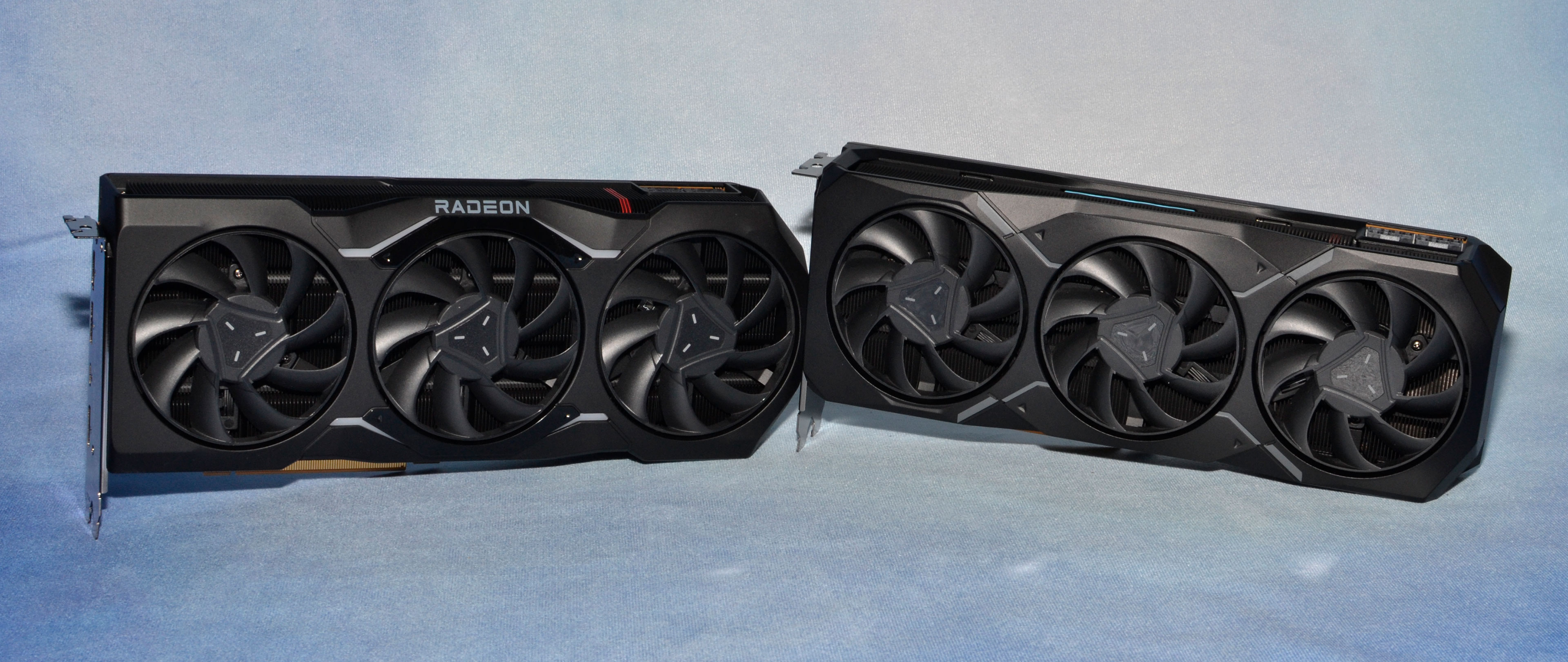Why you can trust Tom's Hardware
Physically, AMD's RX 7900 cards are substantially more compact than Nvidia's RTX 4080/4090 Founders Editions — which are both the same size. The two AMD reference cards look generally similar, though there are some noteworthy differences. For example, the XTX includes RGB lighting where the XT model does not. The XTX is also slightly longer, taller, has larger fans, and of course it weighs more.
The RX 7900 XTX measures 287 x 123 x 51.5mm while the RX 7900 XT measures 276 x 113 x 51.5mm — both have a 2.5-slot thickness. The XTX card weighs 1799g and the XT weighs 1525g, so both cards are heavier than the previous generation 6900 XT that weighed about 1490g. AMD uses custom 78mm fans on the XT card and 84mm fans on the XTX, all of which feature an integrated rim.



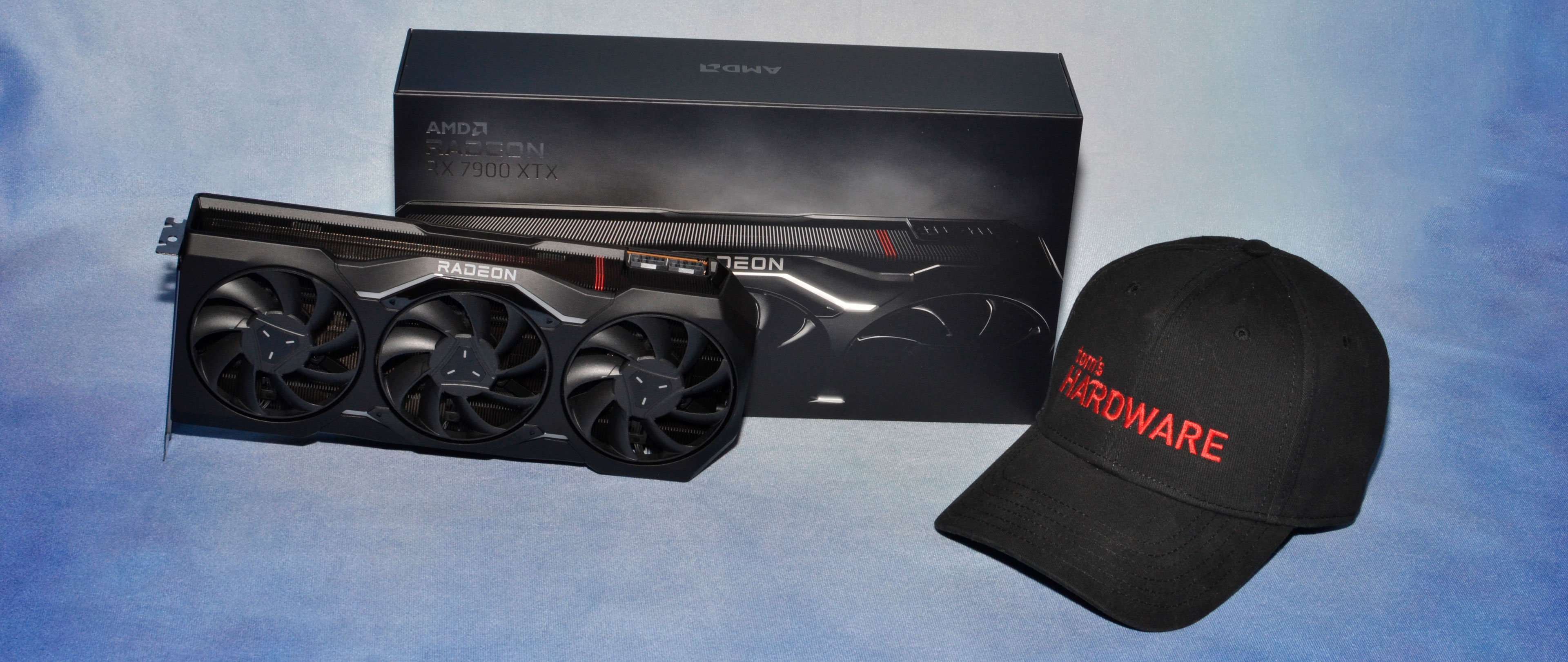









Aesthetically, I like the new design — matte black and sleek looking without a ton of bling getting in the way. AMD's reference designs remind me a bit of Intel's recent Arc A770 Limited Edition and Arc A750 Limited Edition, in a good way. Clean lines, simple and elegant appearance, and not too much flash — especially on the XT card that omits all LED lighting. If you want more bling, of course the usual AIB (add-in board) partners will be happy to provide such cards, though availability on some of those might take a few more weeks.
On the connectivity side of the equation, AMD has a slightly different approach from Nvidia and Intel. There are two full size DisplayPort 2.1 connectors (54 Gbps), one HDMI 2.1 output (48 Gbps), and then a single USB Type-C connector that can support single cable VR headsets as well as DisplayPort 2.1 monitors. DP2.1 54Gbps means AMD can also support up to 240 Hz 4K displays without resorting to Display Stream Compression (DSC), though we've yet to try a DSC monitor ourselves so we're not sure how much DSC truly impacts the user experience.

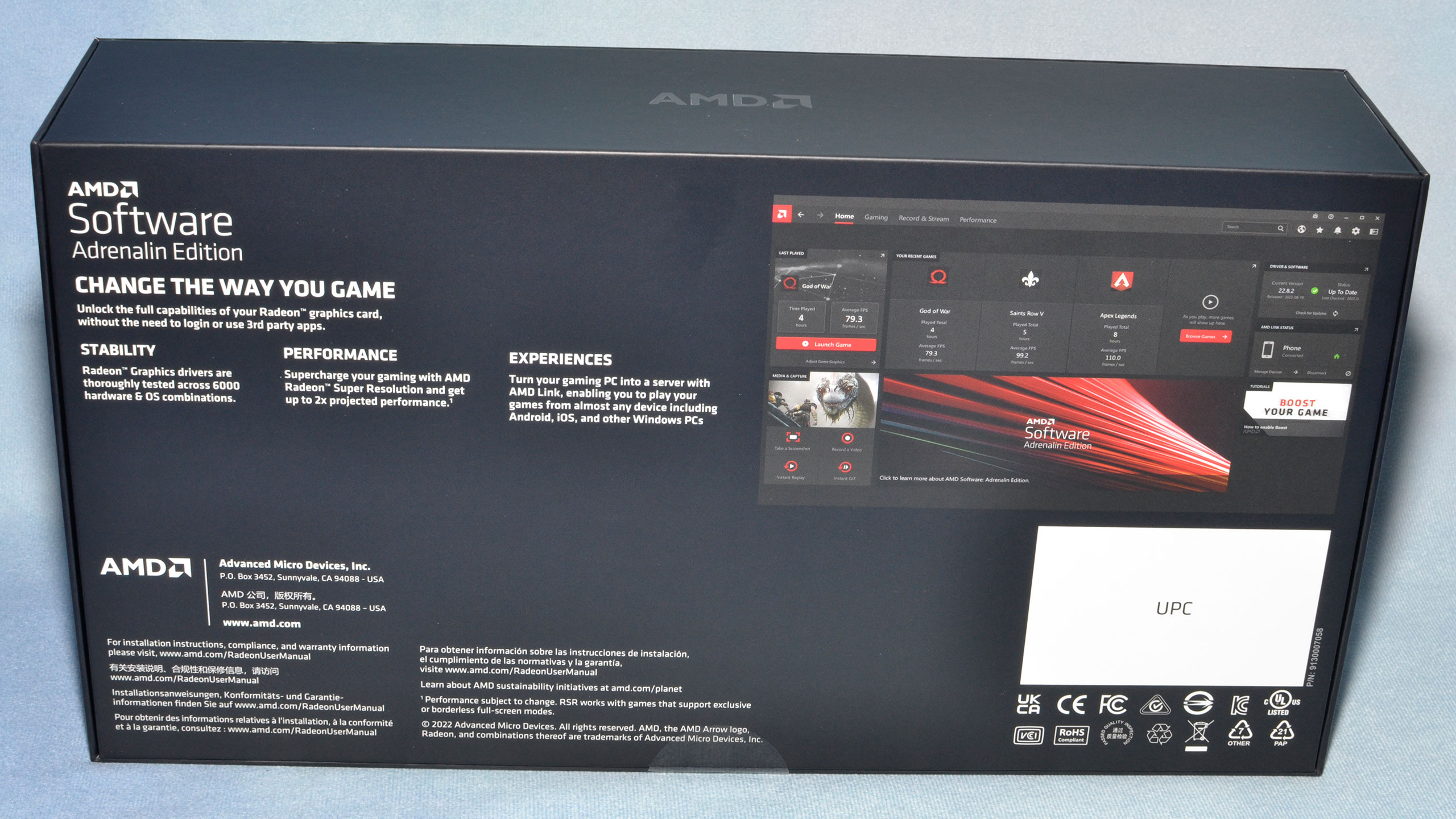
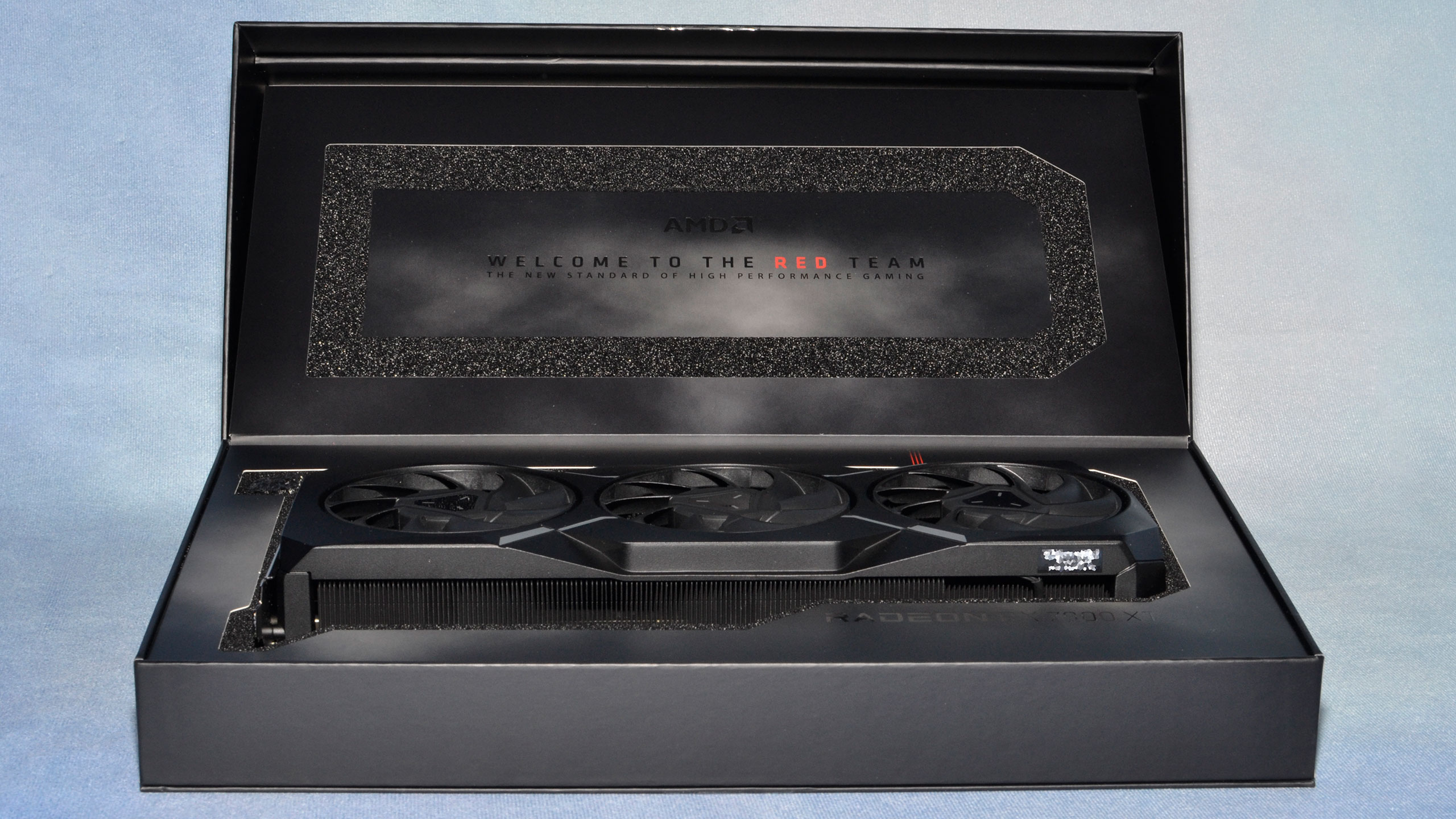

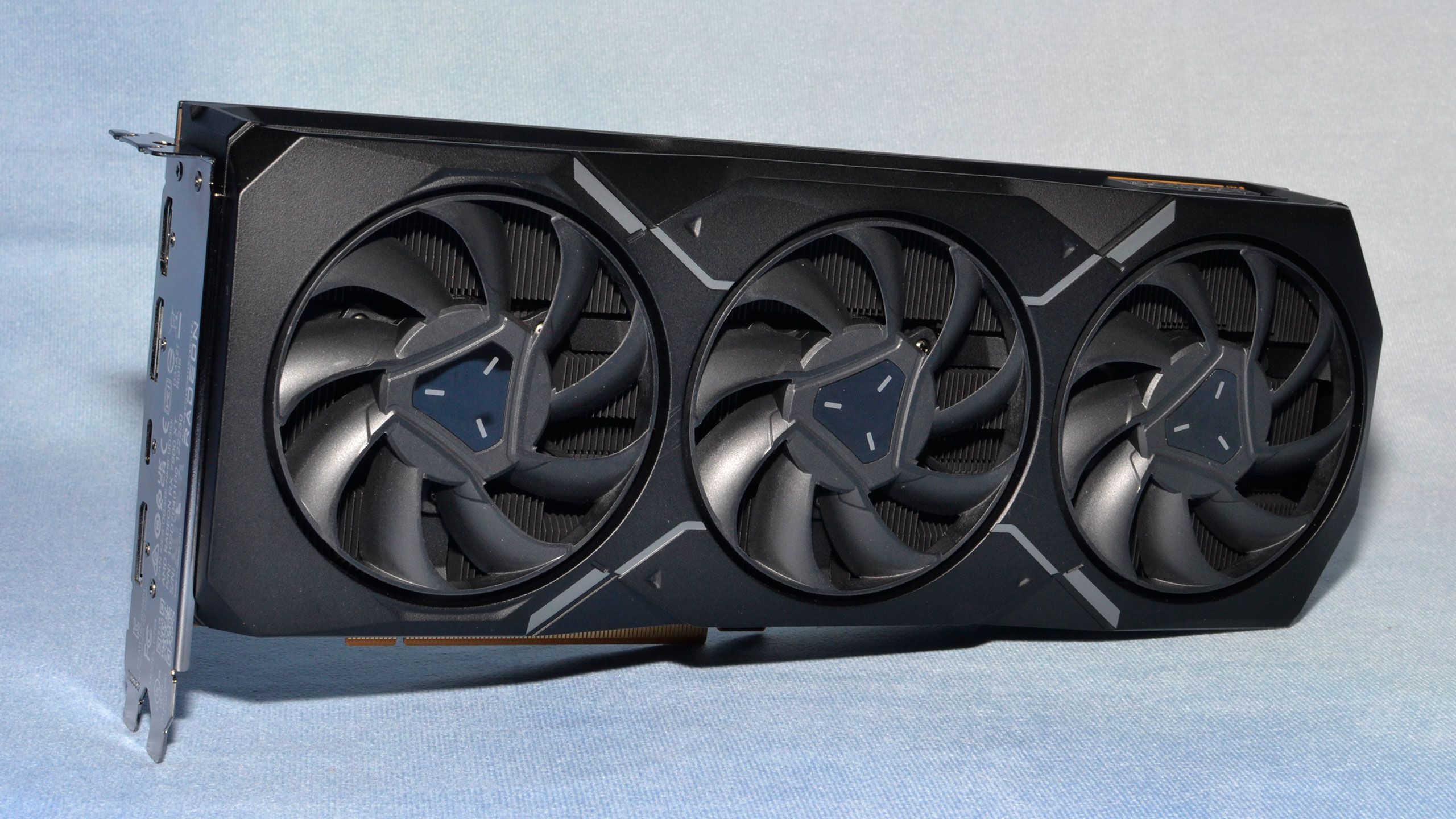


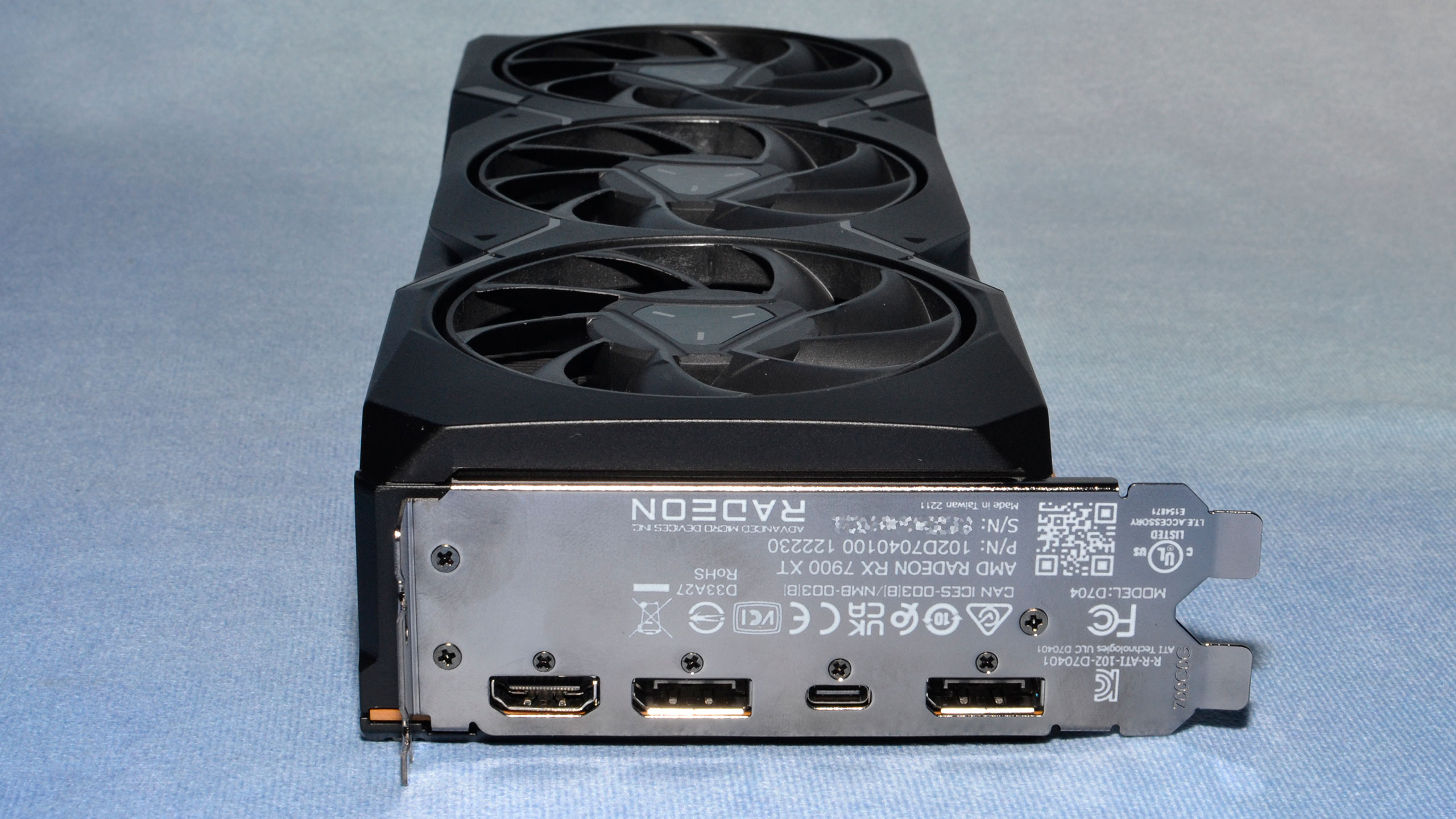




Obviously, a lot of stuff has changed under the surface. Gone is the old monolithic die, replaced by a single larger GCD and six MCDs, which in turn connect to six GDDR6 chips (or five on the XT). The memory is rated for 20 Gbps, and with a 384-bit interface AMD nearly matches Nvidia on bandwidth without the need for more expensive GDDR6X memory.
AMD also skips using PCIe 16-pin 12VHPWR connectors, opting instead for the tried and true 8-pin connectors. Combined with a potential 75W from the PCIe x16 slot, both cards have access to as much as 375W of power, though they generally stay well below that mark. We did see a few spikes into the 400–410 watt range on the XTX while running FurMark, though the PCIe slot power use never got above 56W.
- MORE: Best Graphics Cards
- MORE: GPU Benchmarks and Hierarchy
- MORE: All Graphics Content
Get Tom's Hardware's best news and in-depth reviews, straight to your inbox.
Current page: AMD RX 7900 XTX and XT Design
Prev Page AMD Radeon RX 7900 XTX and RX 7900 XT Review Next Page AMD RX 7900 Test Setup and Overclocking
Jarred Walton is a senior editor at Tom's Hardware focusing on everything GPU. He has been working as a tech journalist since 2004, writing for AnandTech, Maximum PC, and PC Gamer. From the first S3 Virge '3D decelerators' to today's GPUs, Jarred keeps up with all the latest graphics trends and is the one to ask about game performance.
-
-Fran- Thanks for the review!Reply
I'm reading it now, but I've watched numbers in other places. My initial reaction is lukewarm* TBH. I expected a bit more, but they're not terrible either. They did fall short of AMD's promise though. They indeed oversell the capabilities on raster, but were pretty on point for RT increases.
Still, this card better have a "fine wine" effect down the line and the MSRP may just be well justified. This being said, it is still too expensive. for what it is.
Regards. -
spongiemaster ReplyThat's probably because this is the most competitive AMD has been in the consumer graphics market in quite some time.
Not sure how this was determined, but I would argue this is a step backwards in almost every situation from the 6000 series. Also, it should be pointed out that there is something going on with the power consumption of the 7000 series in non-gaming situations that will affect many users. Looks like the memory isn't down clocking or something.
-
JarredWaltonGPU Reply
I don't do a ton of power testing scenarios, so I'd have to look into that more... and I really need to go sleep. As for the "being competitive," AMD is pretty much on par with Nvidia's best in rasterization (similar to 6000-series), and it's at least narrowed the gap in ray tracing. Or maybe that's just my perception? Anyway, since basically Pascal, it's felt like AMD GPUs have been very behind Nvidia. Nvidia offers more performance and more features, at an admittedly higher price.spongiemaster said:Not sure how this was determined, but I would argue this is a step backwards in almost every situation from the 6000 series. Also, it should be pointed out that there is something going on with the power consumption of the 7000 series in non-gaming situations that will affect many users. Looks like the memory isn't down clocking or something. -
Colif Steve appears to have recorded a 750watt transient on the xtx which makes me sit back and wonder what PSU you need. though I am not sure if that is peak system power or just the gpu itself.Reply -
Elusive Ruse A bit of a cynical Pros/Cons section, no mention of XTX being a much better value over 4080 which is its direct competition?Reply
Performance falls within expected margins (reasonable expectations, not that of crazed fanboys). Beating 4080 in rasterization and falling short in RT and professional uses. I don't quite care for RT but the performance gap in Blender e.g. is still eyepopping. I have heard of Blender 3.5 offering big improvements, yet that's not the current reality of things. I also doubt this will be a better story for RNDA 3 in Maya (Arnold) either. -
shADy81 I assume the 750 W transient GN recorded is for the full system? TPU are showing 455W spike for the XTX and 412 for the XT, lower than 6900 and 6800 by quite some way on their charts.Reply
They also downgraded their PSU recommendation to 650 W for both cards. Was 1000W on the 6900. I think I'd feel a bit close on 650 W even allowing for a good quality unit being able to supply more than rated for short times. 650 would surely be way to close for a 13900K system, what do they know that I dont? -
zecoeco Replyspongiemaster said:Not sure how this was determined, but I would argue this is a step backwards in almost every situation from the 6000 series. Also, it should be pointed out that there is something going on with the power consumption of the 7000 series in non-gaming situations that will affect many users. Looks like the memory isn't down clocking or something.
This is actually a bug that was already reported to AMD and they're already working on a fix. -
zecoeco "Chiplets don't actually improve performance (and may hurt it)"Reply
How on earth is this even a con? who said chiplets are for performance? chiplets are for cost saving.
But what did y'all expect ? You just can't complain for this price point.. there you go, chiplets saved you $200 bucks + gave you 24GB of VRAM as bonus (versus 16GB on 4080)
It is meant for GAMING so don't expect productivity performance, for many reasons including nvidia's cuda cores that has every major software optimized for it.
RDNA is going the right direction with chiplets.. in an industry of increasing costs year after year.
Chiplet design is a solution, and not a new groundbreaking feature that's meant to boost performance.
Sadly, instead of working on the problem, nvidia decided to give excuses such as "Moore's law is dead". -
salgado18 ReplyBut for under a grand, right now the RX 7900 XTX delivers plenty to like and at least keeps pace with the more expensive RTX 4080. All you have to do is lose a good sized chunk of ray tracing performance, and hope that FSR2 can continue catching up to DLSS.
That, I believe, is the reason AMD won't increase too much their market share in this generation. Yes, rasterization is comparable, so are power, memory, price and even upscaling performance/quality. But it is a bad card for raytracing, or at least that's the message, and between a full card and a crippled card, people will prefer the fully featured one. I know designing GPUs is a monstrously complex task, but they really needed to up their RT performance by at least 3x to be competitive. Now they will keep being "bang-for-buck", which is nice, but never "the best".
Edit: by some rough calcs, if the XTX is ~40% faster without RT than the 6950, and ~50% faster with RT, then the generational improvement is ~7%? If so, then that's hardly any improvement at all. Great cards and all that, but I'm very disappointed with the lack of focus on RT. -
btmedic04 Replysalgado18 said:That, I believe, is the reason AMD won't increase too much their market share in this generation. Yes, rasterization is comparable, so are power, memory, price and even upscaling performance/quality. But it is a bad card for raytracing, or at least that's the message, and between a full card and a crippled card, people will prefer the fully featured one. I know designing GPUs is a monstrously complex task, but they really needed to up their RT performance by at least 3x to be competitive. Now they will keep being "bang-for-buck", which is nice, but never "the best".
Edit: by some rough calcs, if the XTX is ~40% faster without RT than the 6950, and ~50% faster with RT, then the generational improvement is ~7%? If so, then that's hardly any improvement at all. Great cards and all that, but I'm very disappointed with the lack of focus on RT.
AMD has a definite physical size advantage though which is something thats applicable to quite a few folks (myself included.) I hear what you are saying, but as a 3090 owner, 3090-like RT performance from the 7900xtx is still quite good for most people.
